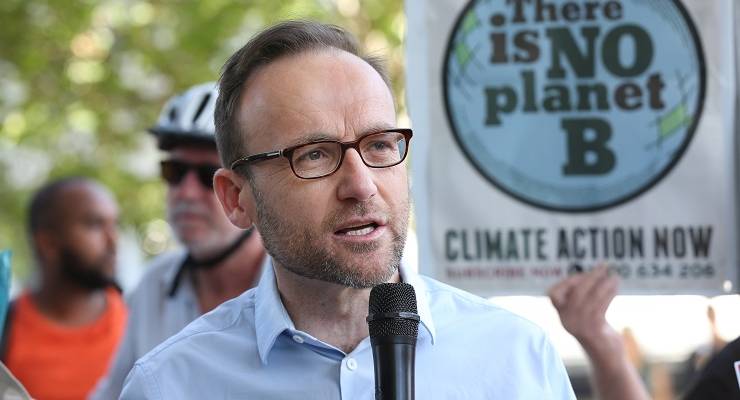
GLORIOUS ADAM BANDT IN GREENS LEADERSHIP WIN! UNANIMOUS VOTE OF CENTRAL COMMITTEE AS DOVE DESCENDS FROM BREAK IN CLOUDS OVER SNOW-CAPPED MOUNTAINTOP OF BANDT’S BIRTH!
That is how I imagine the rightoid press will cover the elevation of the Greens’ new leader this morning.
Bandt was elected unopposed, a recognisably “left” candidate against a more centrist leadership option of either Sarah Hanson-Young or Nick McKim.
The general feeling would appear to be that, whatever benefits and advantages have been gained from Richard Di Natale’s mainstreaming leadership, it’s time to emphasise some different aspects of Greens politics in a new era.
In the interim, I suspect that Di Natale is about to get a little of the scapegoat treatment. From all sides.
In the five years of his leadership, the Greens have stabilised as a party and consolidated their position as a genuine third force.
Remember when Bob Brown quit and Christine Milne took over, all those identikit, wishful thinking press gallery op-eds about how the Greens would fade like the Australian Democrats now that their charismatic leader had gone; and when Milne departed, that the Greens would fade like the… oh, you’ve heard it?
The idea of the “Green fade” was typical of the parochial intellectual mediocrity of the press gallery, which hadn’t bothered to look elsewhere to see how Green parties — such as the German Greens — fared as they went into their second, third, fourth decades.
It never took account of the Greens as the political party expressions of a social movement, and then as the party expression of a new social class.
The damning of the Greens was especially piquant, because they represented what the press gallery said it wanted: rational, policy-oriented politics, looking to steady outcomes and good governance.
Indeed, the only period of stable government and solid legislative progress we’ve had in this country since 2007 was when Julia Gillard governed with Greens support from 2010-13.
Without the Greens, Gillard would have lacked the political skills to stabilise her own government, and Labor would have lacked the discipline to avoid factional warfare.
But acknowledging the Greens in this wouldn’t give anyone the Megalogenis Tingle they seek — the mix of sycophancy to Labor’s “big men” and nostalgia for the Hawke era that launched a thousand op-eds and about two dozen quarterly essays.
So Di Natale’s leadership covered a difficult period, of the brief solid House majority of the 2013-16 Abbott/Turnbull governments, in a period when the Greens had lost control of the crossbench vote.
Furthermore, their membership base was changing underneath them, as an older generation of left-green activists started to power down, and those that remained began to be outnumbered by a new group of “knowledge class” inner-city recruits: highly-paid, socially progressive, green in their beliefs about the planet, but not activists or protesters.
The strategy under Di Natale has been one of engagement, being willing to make some “leapfrog” deals with the Coalition, to engage with the right-wing media, and to be a party implicitly offering itself as a candidate for government at some time in the future.
Whether that was an approach rammed through the party room by Di Natale, or a consensus approach headed by him, I have no idea. But he’ll get the blame, so he may as well get some of the praise for the party staying in the game, in our minimally democratic system of compulsory exhaustive preferences in single member electorates.
But that has not come without cost.
From the moment they were consecrated as a national grouping, the Greens have been, inevitably, fading from their initial role — in proto-Green outfits such as the United Tasmania Group — as the political representation of an activist social movement.
The new knowledge class members were part of the system, not opposed to it en bloc, as many earlier Greens had been, and passionate about social and moral causes such as same-sex marriage and refugees, rather than the destruction of the planet.
The gaining of actual seats supercharged the exhaustive and exhausting internal selection process, which consumed vast amounts of energy.
The party has retained a recognisably left platform — on unions, public sector, renationalisation, etc — that many of its new members, now centrists dedicated to “smart” solutions (i.e. market ones) do not share.
Many of them have little “feel” for the politics of social justice, and a total separation from, if not disdain for, the poor and powerless. The Green triangles have all but disappeared from social protests and actions, and it is rarer still to see such a protest, with any sort of forthright confrontation, initiated by the Greens.
This has happened at the same time as both the crisis of the planet and a crisis of social inequality.
The perception of planetary crisis has spread far more rapidly than the Greens were able to adjust to, and their ability to appeal to youth — in which they once put enormous faith — has diminished.
They have become a party of Boomers and Gen X, many of whose personal interests — in terms of prestige and income — are actively opposed to system disruption as a whole.
Richard Di Natale became the face of that; a collective approach endorsed by some but not all. And, give him his due, he committed.
Out went the Green image of knitted activist/borrowed $90 suit; in came the GQ fashion spread, and the Kraftwerk-style black-and-grey fashion (a source of obvious parody).

Di Natale, a doctor, had come from non-activist life into politics — the Greens remain the only party who have a reasonable proportion of members from actual life — and it was difficult to imagine him locking himself to a gate.
That served to situate the Greens as a party of power and governance. Now something else may be required.
All politics is Green now — we all acknowledging that the planet is a closed-system which must be managed as a matrix of inputs and outputs — and the old parties of left and right are simply bounded within it, as various factions, holding out for legacy positions.
That’s why they’re all such a rabble: the collapsing Libs, the rootrort Nationals, and Sad Labor, fixers and broken romantics.
But for anyone who believes that a radical politics of human crisis is required, the global success of the Greens brings with it great risk.
In Austria, the Greens are in coalition with a right-nativist party. I repeat, IN AUSTRIA. Can anyone think of another Austrian-derived movement which emphasised nature, health, animal rights?
In Germany, the Greens have a recognisable right faction — and though there is much to argue for their strategy, or has been, the worst thing the Greens could become is a system pressure-valve, weakening a sense of global crisis by their presence in government.
In that respect, the Australian Greens could once again play a global vanguard role, showing a way to combine governance and activism. A willingness to take power and a sense of crisis.
They need to start getting arrested, but in good suits.








Some of this article probably helps explain why around twenty per cent of Greens voters regularly preference the Liberals over Labor.
That’s about the same percentage as National voters preferencing Labor over the Libs in (admittedly few now) three-cornered contests.
From another perspective, around twenty percent of otherwise conservative Liberal voters nevertheless opt to give their first preference to Greens: often perhaps as a protest against Liberal stupidity on such issues as climate change.
That would be one way they could go. Or should they start organising now to be the actual people’s choice and government in power? Perhaps not from the next election but the one after – which is, I think, about five or six years away? Given that trends predicted by climate change modelling will be even more evident by then? It may have seemed that the whole country burned this summer but it didn’t. There’s still plenty that could go up next season or the one after if the drought doesn’t break. The denialists seem to be weaselling their way out of it this time and I don’t expect any significant change but another similar season next summer would see the demand for change becoming irresistible.
The Liberals will never be able to rise to this challenge. Life on this planet could become uninhabitable and if it did, they would go to their deathbeds blaming the whole mess on radical, loony Lefties.
I don’t think Labor can rise to the occasion either. They are too weighed down by union conflict of interest: witness their equivocation with Adani at the last election.
That means that the only viable alternative is the Greens … IF they can get their act together in time so that people are prepared to vote for them en masse.
It’s really up to them.
yes, but getting the sort of ‘syriza’ bump, which wld allow votes to suddenly flow to the greens in large numbers, demands that they be seen as representatives of the crisis – which means protest
“Many [new Greens members] have little “feel” for the politics of social justice, and a total separation from, if not disdain for, the poor and powerless.”
??? Evidence?
meeting some of them. ‘many’ does not mean a majority…
Great article – lithe thought Guy. but Hmmm, I question that ‘distain for the poor’ comment too. It’s true we/they are middle class and so definitely a lack of ‘connection’ and consistent RELATIONSHIPS with the poor and powerless – that is in the nature of capitalist driven distancing of the middle class from any one at all- so yes. Always problematic … but….
But I still see the Greens as the you describe us/them early in the article.
We must hold on to the movement positioning – the party of movements – SEVERAL movements including labour movements, health movements, environment and justice movements.
And I think they are doing that to some extent. The parliamentary team and the electoral campaigners and the admin where I come from do strongly amplify and support several justice movements. Strongly where movements are strong and weakly where movements are week. They are thoughtful and responsive and proactive.
There is a lot of evidence that pushing a vision forward along side a strong set of campaigns in a movement is good for votes and good for the movement – so the Greens have been doing that to excellent effect.
Obviously no one joins the party – or the movement – fully formed [except you and me, Guy] so there is going to be lag. But I think the leadership is there, is solid. AND I think it is time for Larissa and Adam to get arrested looking well dressed and spruiking a vision for participation in democracy . They will.
They need to start getting arrested, surrounded by youngsters on ‘Skolstrejk För Klimatet’. If the Greens characteristically consist of knowledgeable people from all walks of life, they will more credibly represent the conscience of the nation.
“They need to start getting arrested, but in good suits.” And wearing the Old School Tie. None of this open neck malarkey in a Lowes suit.
Even Scotty from Marketing could tell Rundle from Grammar that the Greens are unlikely to accept his advice after he’s gone the Godwin (via Austria) on them. It might help him crowdfund another internship at Spiked though.
Spiked contributor, S.O.B
Sorry about that. When I read the Spiked article “Interns, quit your moaning, and seize the day” for some reason I associated it with you. Silly me.